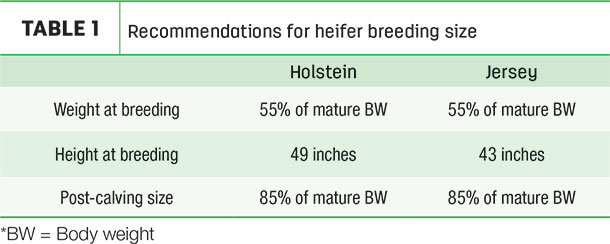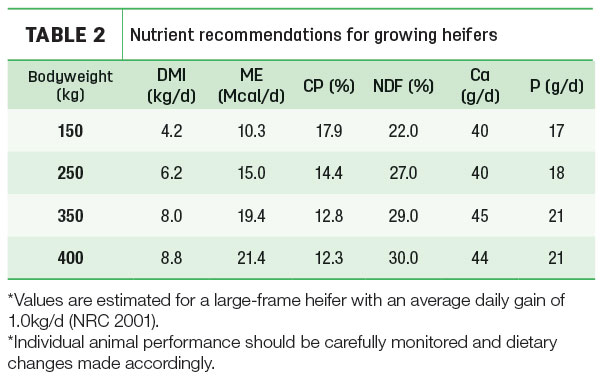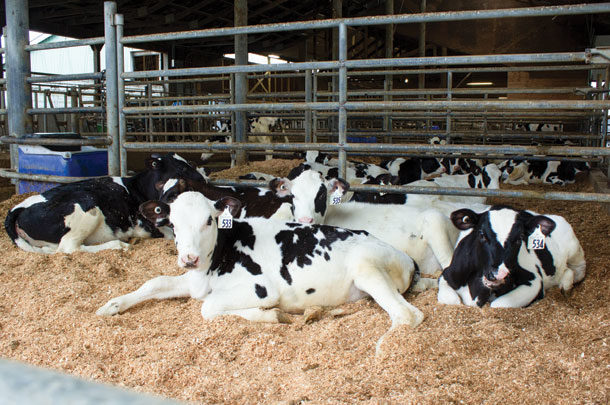Therefore, the process requires precise planning, management and nutrition in order to ensure heifers step onto the right side of the ledger when they begin their first lactation. A first step to achieving this goal is to ensure heifers are bred on time.
When to breed?
Often one of the first questions asked is: “At what age should a heifer be bred?” Currently, most heifers are bred according to age, with the recommendation being 14 months. However, the attainment of puberty is influenced largely by size rather than age, meaning that heifers could potentially be bred earlier when based on size. Therefore, it is possible to start the breeding period at 13 months old, giving producers a head-start on achieving an average age of 22 to 24 months at first calving.
Breeding based on size requires determination of the average herd bodyweight and height measured in third-lactation cows or higher, as well as target average daily gain (ADG) required to meet this size and age goal. Table 1 outlines the industry recommendations for breeding size of Holstein and Jersey heifers.

Based on Table 1, if the average herd weight is 730 kilograms, heifers should be fed to achieve a weight of 402 kilograms (730 x 0.55) by 13 months old. Once bred, they should be grown out to weigh 620.5 kilograms (730 x 0.85) after they calve. Regular monitoring of heifer growth is necessary to consistently identify heifers that can be moved into the breeding group. Pregnancy checking should also be performed to prevent heifers from being open past 15 months old.
Nutritional considerations
A heifer’s eligibility to be bred by 13 months old depends on nutrition as well as any health challenges she might have encountered in her first year of life. Nutritionally, rations should be formulated to meet heifers’ growth requirements as determined by an individual operation’s breeding size goal. Based on the previous example, if a heifer calf weighs 90 kilograms at 2 months old, she should be fed to achieve an ADG of approximately 1 kilogram per day. This will allow her to reach 55% of mature bodyweight by 12 to 13 months old. It is important to note that ADG will vary based on heifer age, feeding strategy, feed quality and environment. Poor-quality forages, lack of grain supplementation and overcrowding can cause significant decreases in growth performance.
For the first six months of a heifer’s life, her nutrient requirements are significant. Table 2 outlines nutrient recommendations for growing heifers.

It is important to offer a highly palatable, high-energy feed along with good-quality legume or legume and grass forages. The use of ensiled forages should be limited and urea avoided in calves less than 5 months old. If ensiled forages are offered, they should be of the highest quality. During the first months of growth, young heifers are developing the rumen for optimal fermentation and digestion. Offering high-quality forages allows for healthy rumen development.
As a heifer approaches breeding size, her dry matter intake (DMI) level increases while nutrient requirements, as a proportion of DMI, decline (Table 2). Proper mineral nutrition is essential to aid in increasing conception rates. Reduced levels of trace minerals such as copper and zinc have been linked to poor reproductive performance. Overfeeding energy will cause fat tissue deposition in the mammary gland competing with secretory cell tissue and endangering animals’ potential productivity.
After breeding, an appropriate rate of gain should be maintained to ensure heifers are calving at 85% of mature bodyweight. Heifers calving too small have an increased risk of dystocia, reduced milk yield and decreased ability to compete with mature cows.
Monitor feed quality on a regular basis and heifer growth rates to confirm the ration formulated is adequate. Separating heifers based on size can help in ensuring the right nutrition is being delivered as well as reduce potential competition between animals.
Ionophores
Ionophores, monensin and lasalocid are available for use in heifer diets. These compounds act to alter rumen fermentation through an increase in propionic acid and decreased acetic and butyric acid within the rumen. This elevates heifers’ ability to capture energy from the diet and can increase average daily gains.
Ration energy and protein must be balanced properly when ionophores are being used. If ionophores are included into diets where free-choice access to high-quality forages is allowed, this could result in overconditioned heifers and reduced reproductive performance. ![]()
PHOTO: A heifer’s eligibility to be bred by 13 months old depends on nutrition as well as any health challenges she might have encountered in her first year of life. Staff photo.

-
Kristin Thompson
- Ruminant Nutritionist
- New Life Mills
Points to remember
- Breed heifers based on size rather than age. Aim for 55% of mature bodyweight.
- Carefully determine the optimal age and weight desired for breeding. Feed and manage accordingly.
- Routinely monitor heifer growth rates.
- Test feedstuffs regularly to ensure appropriate ration formulation.









